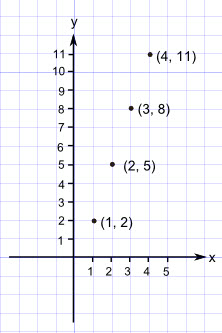Review
GRE Algebra - Functions
Questions on functions at this level are usually restricted to either finding the value of the function for a given value of the variable, or finding the correct domain for a given function.
Common functions include:
- Linear functions, such as f(x) = 3x - 1
- Quadratic functions, such as g(x) = x2 or h(x) = 8x2 + 2x - 3
- Cubic functions, such as f(x) = 4x3 - 7
- Absolute value functions, such as f(x) = |2x + 1|
What is a function?
A relation connects two sets of numbers by some kind of rule. For example, if x is a member of the set {1, 2, 3, 4} and y is a member of the set {2, 5, 8, 11}, then the relation connecting x and y is:
y = 3x - 1
This relation can be represented by a set of number pairs: {(1, 2), (2, 5), (3, 8), (4, 11)}, or by points on a coordinate graph. If you were to use graphing paper to plot these points, you'd get the following:

For a relation to be a function, each member of the first set must be related to exactly one member in the second set. In which case, the first set is called the Domain and the second set is called the Co-domain. The above example is a function because 1, 2, 3 and 4 are each related to exactly one member of the set {2, 5, 8, 11}.
The Domain = {1, 2, 3, 4}
The Co-domain = {2, 5, 8, 11}
But, not all relations are functions. For example, if we change the first set to {1, 2, 3, 4, 6}, then 6 is not related to any member of the second set {2, 5, 8, 11}. By changing one of the sets, we change the nature of the relation.
Functions are usually denoted by letters such as f, g or h. So the above function could also be denoted by f(x) = 3x - 1. So:
- f(1) = 3 × 1 - 1 = 3 - 1 = 2
- f(2) = 3 × 2 - 1 = 6 - 1 = 5
- f(3) = 3 × 3 - 1 = 9 - 1 = 8
- f(4) = 3 × 4 - 1 = 12 - 1 = 11
More generally a function will often be defined from the set of Real Numbers (or a subset of the set of Real Numbers) to the set of Real Numbers (or to a subset of the set of Real Numbers). We denote the set of Real Numbers by R.
f(x) = 3x - 1 can be defined from R to R, in which case, instead of a set of coordinate points, we get all the points on a straight line, which on graphing paper would look like the following:

Finding a Domain
For some relations to be functions, we need to find a suitable Domain. This means, that you need to find the values that are possible inputs to a function, so that the output is defined. Think of the domain as being all of the numbers that can be the inputs for a function, so that the calculated values of the function on those inputs gives output values that are defined. Use the following two possible question types to see the sample thought process that you should go through as you try to determine the domain of a function.
Question: If g is defined by g(x) = √(x-5), then what is a suitable domain for g?
Solution: If you attempt x = 1, then you'll get g(1) = √(-4). Thus, what is the square root of -4? It’s not 2 because 22 = +4, and it is not -2 because (-2)2 = +4 also. In fact, if we square any number, the answer is always positive (or zero), so we cannot get a negative number. So the important point to realize here is that square roots of negative numbers are not defined.
Therefore x - 5 must be greater than or equal to zero, which you can simplify
x - 5 ≥ 0
x ≥ 5
Thus the domain in this case consists of all Real Numbers greater than or equal to 5.
Note that we could have a smaller Domain, but we cannot find a larger Domain. Sometimes this is called the maximum possible Domain, but the question will often simply ask for the Domain, in which case the answer is all Real Numbers greater than or equal to 5.
Question:If h is defined by  , then what is the domain for h?
, then what is the domain for h?
Solution: In this case the function is not defined when x = 7, because

and division by zero is not defined. Thus the Domain consists of all Real Numbers except for 7.